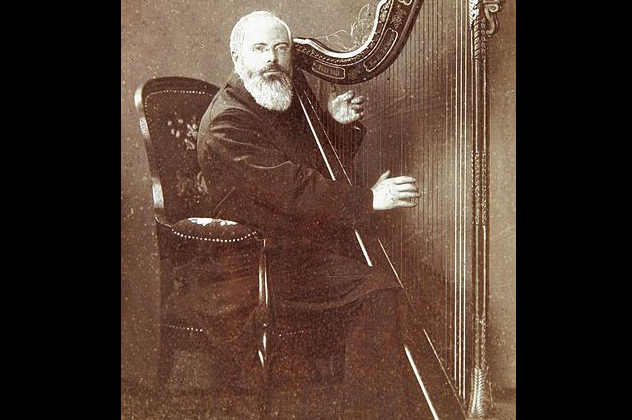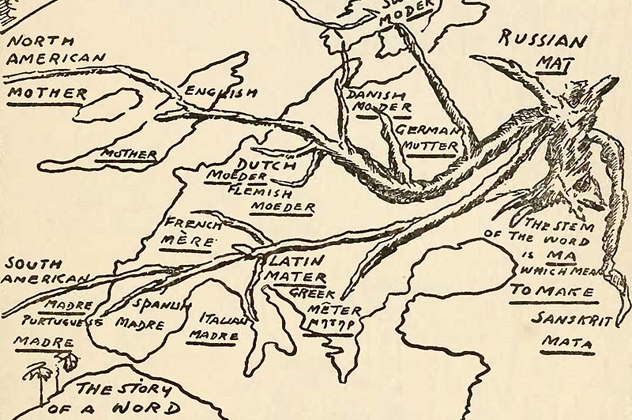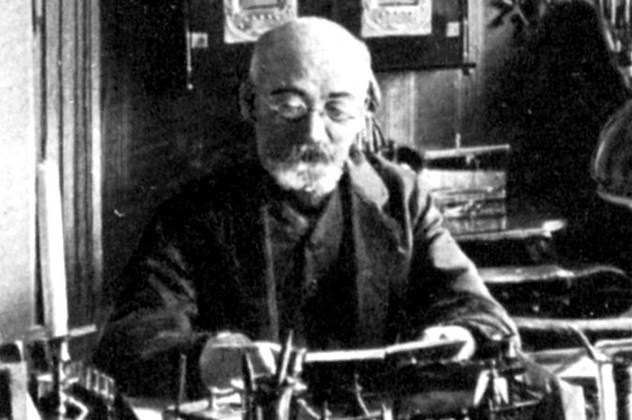 Our World
Our World  Our World
Our World  Travel
Travel Ten Tiny American Towns with Unbelievably Obscene Names
 Crime
Crime 10 Unbelievable Pieces of Evidence Used in Court Cases
 Weird Stuff
Weird Stuff 10 Memorable Intersections Between Alcohol and Sports
 Humans
Humans 10 Incredible People Who Took Their Grief and Used It for Good
 Gaming
Gaming 10 Video Games Surprisingly Banned Around the World
 History
History 10 Significant Events That Also Took Place on November 22
 Miscellaneous
Miscellaneous 10 U.S. Websites Banned in China and Other Countries
 Technology
Technology 10 Technologies That Are Always Going to Be a Few Decades Away
 The Arts
The Arts Top 10 Worst Musical to Movie Adaptions
 Our World
Our World 10 Explorers Who Discovered Lands Virtually Unknown to Any Human
 Travel
Travel Ten Tiny American Towns with Unbelievably Obscene Names
 Crime
Crime 10 Unbelievable Pieces of Evidence Used in Court Cases
Who's Behind Listverse?

Jamie Frater
Head Editor
Jamie founded Listverse due to an insatiable desire to share fascinating, obscure, and bizarre facts. He has been a guest speaker on numerous national radio and television stations and is a five time published author.
More About Us Weird Stuff
Weird Stuff 10 Memorable Intersections Between Alcohol and Sports
 Humans
Humans 10 Incredible People Who Took Their Grief and Used It for Good
 Gaming
Gaming 10 Video Games Surprisingly Banned Around the World
 History
History 10 Significant Events That Also Took Place on November 22
 Miscellaneous
Miscellaneous 10 U.S. Websites Banned in China and Other Countries
 Technology
Technology 10 Technologies That Are Always Going to Be a Few Decades Away
 The Arts
The Arts Top 10 Worst Musical to Movie Adaptions
10 Attempts To Create An Ideal Universal Language
Throughout history, there have been a variety of different lingua francas, or common languages between multilingual populations: Aramaic, Greek, Latin, French. Before the double whammy of British imperialism and American cultural influence established the modern predominance of English, there were a number of attempts to create the ideal language for the human race, and the idea has never really gone away. Esperanto is the most famous example, but here are 10 others.
10Volapük

On a sleepless night in 1879, German Catholic priest Johann Schleyer felt a divine presence telling him to create a universal language. Designed to be easy to learn, it featured a simple system of roots derived from European languages so simplified as to be unrecognizable from their origins. Volapük spread through the middle class rapidly and was seen as a useful international tool of communication in a period before American economic domination sealed the status of English as the lingua franca of Europe. The movement’s popularity faltered with Schleyer’s insistence on umlauts. He said, “A language without umlauts sounds monotonous, harsh, and boring.”
This made the language seem excessively foreign to many, particularly in the United States. Schleyer bitterly resisted any attempt to reform the language, and eventually formed his own splinter movement. Volapük then rapidly disintegrated into rival variants, all of which fell into benighted obscurity with the rise of Esperanto. Up until the 1960s, the phrase “to speak Volapük” was a French idiom meaning to talk nonsense or gibberish, though the expression had fallen into disuse until Nicolas Sarkozy used it in 2010 while complaining about UN climate summit negotiations, temporarily confusing his interpreters.
9Blissymbols

Developed by Charles K. Bliss, this communication system was designed as a universal written language that everyone in the world could use regardless of their mother tongue. While working as a photographer and filmmaker in Shanghai during World War II, Bliss became fascinated by Chinese characters, their history, and the notion that speakers of different languages could share a single written system. He decided to develop a more scientific version of this idea as Blissymbols, which combined elements from mathematics, molecular formulas, and electrical pictorials.
Some of the symbols were pictographic, representing physical objects like a house or the Sun, while other symbols were ideographic, representing ideas like the mind or the act of giving. These symbols were designed to be easy to draw and combine to form complex concepts that would allow people of different languages and cultures to communicate effectively. With a base of 10 simple icons, the symbols could then be combined to create complex meanings. The end goal was to create a means by which humans could communicate without misunderstandings, which Bliss believed was the root cause of much of the world’s suffering.
While Blissymbolics never caught on as an international communication tool, they were used in the 1970s to help individuals with cerebral palsy communicate, and in the mid-1980s, 12-year-old Rachel Zimmerman developed a Blissymbolic Printer that allowed non-speaking patients to communicate effectively through a computer screen. This system is still used by thousands of physically disabled individuals.
8Modern Indo-European

The Dnghu Association is a European nonprofit organization dedicated to the revival of the ancient North-West Indo-European language as a common tongue for the European Union and its promotion as an international auxiliary language. The Indo-European language family group is the largest modern language family, including the Germanic, Romance, Slavic, Celtic, Baltic, Albanian, Hellenic, Iranian, and Indo-Aryan language branches, as well as the extinct Tocharian and Anatolian language groups. The North-West Indo-European language is considered by some linguists to be the common ancestor of modern Germanic and Romance languages, and thus a revived and revised Modern Indo-European is seen as a “natural and common” language for all of Europe (the Basque, Hungarians, Estonians, and Finns notwithstanding).
The name of the organization comes from the Indo-European word “dnghu,” meaning “tongue,” from which emerged the Latin “lingua,” and the English “language” (and “tongue,” via Germanic). The language was earlier known as Europaio, but the name was changed to Modern Indo-European to distance the project from purely artificial languages like Esperanto. Critics of the movement have criticized it as being essentially the work of amateurs with a political agenda who do not respect actual Indo-European linguistic scholarship. Those interested in learning Modern Indo-European can find the complete grammar available online through Creative Commons.
7Interglossa And Glosa

In 1943, linguist and biologist Lancelot Hogben published “Interglossa: A draft of an auxiliary for a democratic world order, being an attempt to apply semantic principles to language design.” He advocated a language without flexions and endings that took its vocabulary from Greek and Latin, and its syntax and word order from Chinese.
Hogben’s philosophy was based on the idea that “the best grammar is no grammar,” a concept itself based on an earlier Latin-based auxiliary language called Interlingua. To Hogben’s surprise, the language was not an immediate hit among a British public somewhat preoccupied with the war on fascism, and the language lay dormant until it was rediscovered by enthusiastic scholar Ron Clark in 1960. Clark was joined by another enthusiast, Wendy Ashby, in 1972, and after Hogben’s death in 1975, Clark and Ashby renamed the language Glosa to represent a shift to a phonetic spelling system less constrained by Greek conventions.
Each Glosa word represents an idea and can work as a verb, noun, adjective, or preposition, with the grammar taken over by operator words and word order. Glosa maintains a healthy online presence and can be learned through freely available materials.
6Real Character

An early attempt to create a universal character system like Blissymbolics was produced by Dr. John Wilkins in the 17th century. In 1668, Wilkins received a royal commission to write “An Essay Towards a Real Character, And a Philosophical Language.” Wilkins was known for his esoteric interests: theology, cryptography, transparent beehives, music, and the possibility of lunar travel. He aimed in his work to create a language of universal linguistic traits, which could then be used as a replacement for Latin as the lingua franca of Europe and to help spread “true religion.” The idea was to create a system of “real characters” with fixed meanings that would be readily understandable across language gaps in the same way that mathematical symbols are universally understood.
He considered Hebrew to be the most appropriate choice, having the fewest redundant radicals and also being the closest to the language of God. He also developed a philosophical language that could be spoken and written, but unlike Latin, that language had no irregularities and no exceptions. He did this by attempting to divide everything in the universe by taxonomy into 40 classes, which were given two-letter monosyllables, further divided into “differences” by adding a consonant, and then into “species” with an added vowel. “De,” meaning “element,” formed the basis of “deb” (“fire”), which became “deba” (“flame”). The real character and philosophical language systems designed by Wilkins were actually an awkward fit with one another. Famed author Jorge Luis Borges would go on to criticize Wilkin’s scheme as unavoidably arbitrary.
5Solresol

In the early 19th century, the musician Jean Francois Sudre developed a method of associating letters of the alphabet with musical notes, allowing him to ask his students questions by playing his violin, which they responded to on piano. Sudre thought the technique, later known as Telephonie, could be used as a form of long-range stenography, but the Ministry of War saw it as a potential night telegraph. Despite successfully relaying messages such as “You will destroy the bridge at dawn” via bugle, the military concluded that it was of limited use.
After repeated failed attempts to convince the army and navy, Sudre turned instead to using the language as a way to help the blind and deaf to communicate. Sudre abandoned Telephonie in 1829 in favor of a new system, the musical language Solresol, which had seven phonemes based on the Western musical scale: “do re mi fa so la si” (the latter known as “ti” in English). Combinations of musical notes would be combined to form words, meaning that Solresol could be communicated through speaking, singing, humming, or playing a musical instrument. Sudre even developed ways to express the language through the ROYGBIV color spectrum, hand signals, and numbered tapping.
The language had a deliberately limited range of possible vocabulary by including combinations of only four phonemes, allowing for a mere 2,660 different words, which was much less than natural languages and also featured a reasonably simple grammar that allowed words of reversible meanings: “Misol,” (“good”) is reversed to “solmi” (“bad”), as just one example. Despite producing Solresol dictionaries in multiple languages and giving popular demonstration before royalty and curious crowds, Sudre’s death saw the slow decline of the musical language, though it has been revived online in recent years.
4Ido

After the collapse of Volapük, Esperanto became the most popular artificial language scheme, first published by Dr. Lazarus Zamenhof in 1887. Rival auxiliary language Idiom Neutral also emerged, developed by ex-Volapükists with the idea of choosing words based on their commonality in the seven major languages of Europe. Although considered somewhat ugly and lacking enough grammatical oomph to really sell it, it was nevertheless extremely influential in the development of yet another proposed auxiliary language: Ido. Esperanto was based on “Fundamento de Esperanto,” a document that set its inviolable basis and which caused controversy between conservative Esperantists who resisted reform and those who saw flaws in Esperanto, such as the use of cumbersome circumflex letters, jaw-breakingly difficult conjugation, and the awkward use of “-j” for plurals.
Unstable behavior by Zamenhof helped lead to a schism, creating Ido, which derived from the Esperanto word for “offspring” and sought a middle ground between Esperanto and Idiom Neutral. Ido emerged from the 1907 Delegation for the Adoption of an International Auxiliary Language in Paris, which ended up choosing Esperanto as its preferred option but saw pamphlets outlining Ido left underneath the tables of delegates. Despite the fact that it originated as a reformed Esperanto, personal animosity soon led to Ido forming its own separate movement which criticized Esperantists for being dogmatic and anti-scientific. They also claimed that Ido was a rational development on par with the metric system. Esperanto remained the most successful auxiliary language in history despite these heretics.
3aUI

One of the most bizarre constructed languages is aUI, translating as “space-spirit-sound.” It was developed by Austria-born Iowa psychologist John W. Weilgart, who allegedly claimed to have learned it as a child from a green alien humanoid who said that aUI was the universal language of logic used throughout the cosmos. Unlike other attempts to create a universal language, aUI is unrelated to any existing human language and makes no attempt at naturalism. Weilgart wished to create a language that allowed for free expression of ideas while remaining deeply wedded to inherent meaning in order to safeguard against the manipulation of meaning and the use of metaphor to confuse understanding and communication. He determined what he believed were the 31 fundamental universal elements of meaning and associated each with a vowel or consonant.
So, “p” (“before”) is combined with “O” (“feeling”), creating word-concept “pO,” or “anticipation.” In another example, “f” (“this”) combines with “u” (“human”) to create “fu,” or “this-human.” In other words, “me.” Combining “b” (“together”) with “u” creates “bu,” or “together-human,” meaning “you.” All words in aUI are similarly innately tied with their root meanings, which Weilgart believed would reduce prejudice and misunderstanding.
Weilgart believed in the universal applicability of his language: “The Language of Space is the cosmic communication, whose elements can be learned in an hour. It is the primeval language of the Logos of pure reason that takes our human race back before the confusion of Tongues at the Tower of Babel.” While fascinating, the language has little modern following, being extremely counterintuitive to human linguistic standards, so we will have to wait for the Zeta Reticulans to send native-speaking instructors and audiobooks.
2Ithkuil
This artificial language was developed by John Quijada “to attempt the creation of what human beings, left to their own devices, would never create naturally, but rather only by conscious intellectual effort: an idealized language whose aim is the highest possible degree of logic, efficiency, detail, and accuracy in cognitive expression via spoken human language, while minimizing ambiguity, vagueness, illogic, redundancy, polysemy (multiple meanings) and overall arbitrariness seemingly ubiquitous in natural human language.”
Quijada was inspired by the politics of Esperanto and through exposure to a French prog-rock concept album sung entirely in a melodic alien language created by the lead singer. His early attempts to create a language were mixed successes: Mbozo, “a relexified generic Romance/Germanic hybrid with African-like phonology,” and Pskeoj, which had vocabulary derived from punching randomly on a typewriter. When studying exotic languages, Quijada became intrigued by the idea that every language has something that it does better than all other languages. Ithkuil was developed as an attempt to combine all the advantages of different languages around the world as a perfectly efficient language able to communicate information as succinctly and precisely as possible.
Ithkuil allows for words such as “Onxeizvakcispourboi,” meaning “emotional and psychological impact that one has in realizing too late that one’s actions and consequences of those actions have gradually killed the hopes that your lover had that this was going to become a long term monogamous relationship.” After being mentioned in the Russian popular science journal Computerra, it underwent a bizarre explosion of popularity in Russia that was linked to a fringe academic movement called “psychonetics,” a mystical self-help philosophy centered on developing “technologies of human consciousness.” The goal is perfect perception: “A psychoneticist must have nothing unconscious. Everything must be conscious. This is the same goal as Ithkuil. Human beings have a linguistic essence, but we are in a transitional stage to some other essence. We can defeat and conquer language.”
Quijida has distanced himself somewhat from Ithkuil, describing it as a “25 year itch” successfully scratched, and expressed his feelings with the sentence “Eipkalindholl te uvolilpa ipcatorza uxt ri’ekcuobos abzeikhouxhtou eqarpa? dhai’eickobum ot euzmackuna? xhai’ekc’oxtimmalt te qhoec ityatuitha?,” meaning, “I am privileged to have had the rare experience of having what I think of as a hobby propel me to faraway places where one encounters new ideas along with new cultures and new peoples generous in their hospitality and respect, leading me to humble introspection and a new appreciation for the human spirit and the wonders of the world.”
1Lojban

In 1955, the Loglan project began to test the Sapir-Whorf hypothesis, which states that the language a person uses determines the way they think. The work of the creator, Dr. James Cooke Brown, was released in a 1960 issue of Scientific American, and Loglan appeared in several science fiction novels, such as Heinlein’s The Moon is a Harsh Mistress. The language was intended to be based on predicate logic, drawing in vocabulary from the six most commonly spoken world languages, arranged logically and symbolically in a simple, unambiguous grammar form, which Brown believed would increase the mental capacity of the speakers.
The rush of interest in Loglan led to others attempting to participate in expanding and developing the language with their own ideas, causing Brown to attempt to claim intellectual property rights. Power struggles between Brown and the Board of Directors at The Loglan Institute saw the loss of many volunteers, and progress became frozen. After a legal attempt to claim trademark infringement failed in 1992, the open-source version of Loglan, known as Lojban, emerged and has developed in popularity on the Internet over the last 20 years.
Lojban enthusiasts point to its many advantages, one of which is the way it allows the efficient expression of emotion through attitudinals, which work as verbal emoticons. They also point to its unambiguous syntax and expanding vocabulary, flexible pronunciation, and cultural neutrality. In addition, the language is readily understandable by machines, meaning that it could be used in the future as a way to communicate with artificial intelligences.
David Tormsen uses British spelling conventions to annoy Americans, and vice versa, which shows you his general attitude towards language. Colour looks naked without a “u,” but Sid Meier spelled “civilization” correctly.







